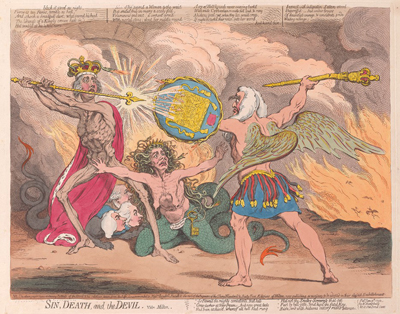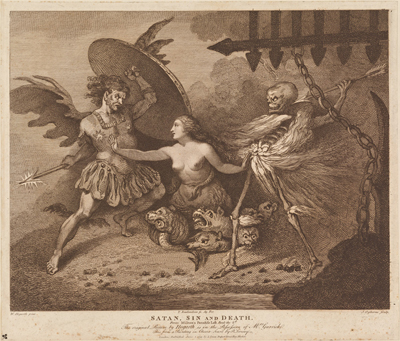Sin, Death, and the Devil
This is the second and most daring of two prints published within a few weeks of one another portraying the power struggle between Prime Minister William Pitt (on the left) and the Lord Chancellor Edward Thurlow (on the right) while Queen Charlotte (in the middle) attempts to intercede, protecting Pitt. The other print was The Fall of the Wolsey of the Woolsack published May 24th, 1792.

© Beinecke Rare Book & Manuscript Library, Yale University
The struggle was simply the latest instance of a fundamental enmity between Thurlow, the long-time Chancellor and servant of the King, and Pitt, the young Prime Minister and leader of the Tories. In the recent debate over the National Income and Expenditure Bill, Thurlow (always gruff and blunt) had been both abusive of Pitt and dismissive of his ideas. Pitt had seen and heard enough. After the vote (which he won) Pitt declared "that Lord Thurlow was of no service whatever to the Administration for that he opposed every thing and proposed nothing." (Evening Mail, May 18, 1792). He then wrote to the King, presenting him with an ultimatum: he (Pitt) would resign if Thurlow were allowed to stay. The King sided with Pitt.
Thurlow could certainly have anticipated the confrontation, but he was evidently surprised by the result. According to Wright and Evans, in their commentary on this print, Thurlow "was astounded at the King's ready acquiescence, and said to his friend, Sir John Scott. . .'I did not think that the King would have parted with me so easily.'" He made two errors: the first was assuming that his long tenure as Chancellor would trump whatever influence Pitt had with the King; but even more importantly, he underestimated the power of the Queen who had not forgotten Thurlow's readiness to give up on her husband during the Regency crisis.
With King and Queen both supporting Pitt in real life it is not surprising that Gillray portrays Pitt armed with the royal sceptre and wearing the king's crown and robe. But though fighting for the King and with the Queen's support, there is still the suggestion (carried over from earlier Gillray prints) that Pitt may be appropriating too much of royal power for his own sake. On the other side, Thurlow is identified by a shield emblazoned with the Lord Chancellor's Purse and Woolsack, and wields the Chancellor's mace as his weapon. The mace is shown partially broken because by June 9th, when this print appeared, Thurlow had already been fired, though he still retained some power while a replacement was being sought.
The fundamental design of Sin, Death, and the Devil is derived from a painting of Satan, Sin, and Death (1735?) by William Hogarth which was in turn inspired by lines from John Milton's Paradise Lost, Book Two, quoted, with some changes, in Gillray's version, above and below the image. But the immediate impetus for Gillray's print probably came from the publication of a print on June 1st 1792 etched by Gillray's friend and competitor Thomas Rowlandson based on the Hogarth painting. Gillray would have seen the applicability of the image to the recent and very public dismissal of Thurlow, and he would have enjoyed the opportunity to parody another piece of "high art" as he did in Shakespeare Sacrificed (1789) and Wierd Sisters. Ministers of Darkness. . . (1791) and to mock the art establishment of Boydell and Fuseli.

Satan, Sin, and Death [June 1, 1792]
© New York Public Library

© Beinecke Rare Book & Manuscript Library, Yale University
Gillray retains the basic configuration of Satan, Sin, and Death, but changes their respective locations and some of the details. In the print of Hogarth's painting, the battle takes place before the portcullis marking the gates of hell. In Gillray's version the contest is waged before what looks like the entrance to the Treasury we have seen in prints like A New Way to Pay the National Debt (1786) and Monstrous Craws (1787). The "the fatal Key,/Sad instrument of all our woe," as Milton describes it, opens the portcullis from Hell to the not yet fallen world in Paradise Lost and presumably in Hogarth's painting. But in Gillray's version it more likely opens the gates to the Treasury and political power. And as in Milton, the key is maintained by Sin (the Queen).
In Gillray's version, the position of the combatants is reversed. On the left is Pitt whose gaunt and boney form certainly lent itself for the portrait of Death. And given the outcome of the political contest between Pitt and Thurlow, the characterization is appropriate. Over him are words derived from two non-consecutive passages of Paradise Lost which partly account for the presence of Pitt's crown.
. . .black [he] stood as night,
Fierce as ten Furies, terrible as hell,
And shook a dreadfull dart; what seem'd his head
The likeness of a Kingly Crown had on;
Hell trembl'd at his hideous Name.
On the right is Thurlow in the role of Satan, whose pride, like Thurlow's contributed to his downfall. Over his head, the following lines appear:
Incenc'd with indignation Satan stood
Unterrified,—but under brows
Of dauntless courage, & considerate pride
Waiting revenge.
The final two and a half lines do not appear in Paradise Lost. They were obviously added by Gillray. But they certainly remind one of Thurlow's response to his dismissal according to Wright and Evans: "As to that other man [Pitt], he has done to me just what I would have done to him, if I could."
In the middle is Queen Charlotte as Sin accompanied by the Hell Hounds: Dundas, Grenville, and Richmond—all members of Pitt's inner circle. In contrast to the portrayal of Sin in both Milton and Hogarth, Gillray shockingly shows her as old and hag-like, deleting the word "fair," which appears in Milton at the end of the first line:
She seem'd a Woman to the waist
But ended foul in many a scaly fold
Voluminous and vast, a serpent arm'd
With mortal sting: about her middle round
A cry of Hell-hounds never ceasing bark'd
With wide Cerberian mouths full loud, & rung
A hideous peal; yet, when they list, would creep,
If aught disturb'd their noise, into her womb,
And kennel there.
As in the Hogarth print, Sin (Queen Charlotte) seems to be intent on protecting Death (Pitt) from a determined Satan (Thurlow). But Gillray adds a much stronger sexual element as Pitt stands open-legged like a boxer and the Queen's hand is held directly before Pitt's genitals.
During the months of the King's madness (October 1788 - February 1789), Pitt and the Queen shared a common agenda: to delay and limit the power of the Prince of Wales in case of a regency. In the Regency Bill that Pitt finally and reluctantly got through the Commons, the Queen maintained control of the royal household and access to the King, and the Prince was prevented from selling off property, controlling patronage, and changing administrations. As their names and goals became linked, (unfounded) sexual innuendoes began to be made in prints such as The Q.A. [Queen's Ass]. . . (December 1788) and Gillray's Hopes of the Party. . . (1791). This is another one.
As Draper Hill notes in his biography, Mr. Gillray - The Caricaturist (pp. 45), Gillray may not have realized (or cared) how offensive the image might be to the Queen. His job was to create provocative images to portray and provide insight into contemporary events. In this he succeeded beyond anything he could have anticipated.
Sources and Reading
- Commentary from the British Museum on Sin, Death, and the Devil.
- Draper Hill, Mr. Gillray The Caricaturist, 1965, p. 45 Pl. 44
- "William Pitt the Younger," Wikipedia
- "Edward Thurlow, 1st Baron Thurlow," Wikipedia
- "Charlotte of Mecklenburg-Strelitz," Wikipedia
- Thomas Wright and R.H. Evans, Historical and Descriptive Account of the Caricatures of James Gillray #86*
- Thomas Wright and Joseph Grego, The Works of James Gillray, the Caricaturist; With the History of His Life and Times, pp. 146-147.
Comments & Corrections
NOTE: Comments and/or corrections are always appreciated. To make that easier, I have included a form below that you can use. I promise never to share any of the info provided without your express permission.